 |
|
 |
|
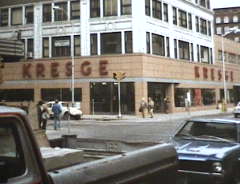 Variety stores, like this Kresge in downtown Des Moines, Iowa, were the forerunners of the modern discount department store. They both managed, despite several closings, to co-exist in the retail landscape for more than 30 years, but most variety stores--even the larger ones--saw sales decline with each passing decade and eventually closed their doors.
Variety stores, like this Kresge in downtown Des Moines, Iowa, were the forerunners of the modern discount department store. They both managed, despite several closings, to co-exist in the retail landscape for more than 30 years, but most variety stores--even the larger ones--saw sales decline with each passing decade and eventually closed their doors.
|
|

|
|

|
When the last 300 or so remaining Woolworth variety stores closed their doors forever in 1997, many regarded it as the end of a significant era in retail history. But for me, the saddest loss of all in terms of once-popular shopping destinations was that of the first-generation discount department stores which began springing up in selected areas as early as 1956--those 65,000 to 110,000 square foot shrines to inexpensive merchandise for the masses with interior walls painted aqua, salmon and dull yellow, with huge, gaudy signs in the midst of the parking lot which often had a large, red arrow pointing straight at the store and rows of neon tubing or flashing light bulbs. To earlier generations raised solely on shopping trips to the "five and ten" or the traditional stately department store, these sprawling monsters were either a boon to thrifty one-stop shopping, or a garish monument to stuff that was "cheap" in every sense of the word, sold by inexperienced high school grads. But to MY generation, they were the stuff of baby boomer dreams. Shopper's World. Shopper's Fair. GEM (some locations called GEX). Atlantic Mills and Spartan, which later merged. Community Discount World. The Giant Store. Ardan. Arlan's. Gulf-Mart. French Market. Two Guys. T G & Y Family Centers (which grew out of T G & Y Variety Stores). White Front. Zayre. Zody's. All doing good business. All thriving and surviving. All making for much-anticipated destinations during a weekend drive around the metro area, at a time when the big car was more or less king of the road, and it cost less than five bucks to fill the tank. Equally inexpensive was much of the merchandise which could be had at the discount stores of that era. Summer print dresses for around $4 or $5. Men's slacks for about the same price--no overpriced designer duds at these places. While these stores might not have been one's first choice from which to buy a TV or hi-fi console (the precursor to audio components), they attracted a lot of record buyers who grabbed all the latest hit LPs for two or three bucks a pop (a dollar more for stereo)--with much of that music making for a fitting soundtrack for this type of shopping spree, at that. And then there were those toy departments--the Holy Grail for us '60s kids whenever our folks took us to stores of this type. My absolute favorite was the game section. Every year I looked forward to seeing what new titles would be added to the list, especially those brought out by the Ideal Toy Corporation, whose specialty was mostly "boardless" games with big plastic pieces, springs, marbles and steel balls, packed in boxes three to six inches deep. Many were designed by Marvin Glass, the Willy Wonka of game inventors, who together with Ideal is credited with unleashing Mouse Trap on an unsuspecting public back in 1963. Back then, it came in a 14 x 22-inch box and sold for less than $5 at most stores, as did its less-successful 1964 follow-up, Crazy Clock. Today's Milton Bradley version of Mouse Trap is priced around $15, comes in a smaller box about the size of Ideal's 1965 Fish Bait game, and doesn't even have the old plastic "bowling ball" anymore! I also enjoyed seeing the newest editions of the "Concentration" home game. It was interesting to see what color scheme they'd use with the familiar graphics on the box cover each year. These were relatively inexpensive as well, and a good thing too, for I wound up having to get no less than four different editions during the '60s due to that roll of 59 (touted as 60) puzzles which I always found easy to memorize once I'd been through the roll. Yes, those were great times, visiting the toy departments at the old discount stores during those sunny, less-inflationary years, even if you had to wait for Christmas to get some of those things (at least you could buy Plastigoop for your Mattel Thingmaker year-round). But those times weren't always great. Back in those days before game boxes were plastic-wrapped, some stores' game aisles displayed the dreaded "Do Not Open Boxes!" sign (one such store was Shopper's Fair in Des Moines, Iowa, where I got my first-ever look at Crazy Clock during a Friday night visit there with my aunt in the fall of 1964), when I preferred to take a look inside to see what the actual pieces looked like. I had no intention of getting the things out and playing with them, but some kids did. Even more dreaded was the possibility that, sign or not, some mean old manager passing by would spot a lad peering into a box he'd opened and lower the boom on the poor kid--and yes, I had a couple of encounters like that growing up. Still, an occasional setback such as this didn't affect my overall appreciation of the great old discount department stores. They were great places to spend a few bucks when a few bucks were all you had to spend. Sadly, 1973 marked the beginning of the end for most of them. Inflation was getting worse along with the nation's economic situation, the overall mood of America was growing less-optimistic, President Nixon and several of his associates had their troubles, and it seemed like each week brought news of yet another raw material that was suddenly in short supply. We went from Petula Clark singing the praises of going downtown where the neon lights are pretty, to Joni Mitchell's musical lament about "paving paradise and putting up a parking lot". Shopper's Fair was one of the first to go after 1973 began. Atlantic and Spartan-Atlantic folded shortly afterward. So did White Front and their Topps division. And on it went through the decade. During the '80s and '90s, we even lost discount chains I thought would be around forever, such as Woolco (out of Woolworth), Venture (which began in 1970), and even T G & Y. With a handful of exceptions, it got to the point where only the hardiest chains were able to continue and grow. Events have decreed that virtually all of our future discount store purchases will be made at the Big Three Surviviors, Target, K Mart and Wal-Mart. All of them got their start in 1962...but the folks who backed them way back then probably never dreamed they'd one day have the lion's share of the nation's discount store landscape. So before they're completely forgotten, here is a look back at a few of the great old discount department stores of days gone by. |
Shopper's Fair
Shopper's Fair as it looked in South Bend, Indiana, circa 1960. Des Moines, Iowa got one about the same time--but with a far-less appealing parking lot sign. At right: an advertising logo from the chain's early '70s waning days. |
Here's a message I received from Vince Iuliano, who remembers the South Bend location:
There was a puppet show on at the time (1960) that was fairly popular in the midwest. It was called "The D D Donovan Show" and the main puppet was a puppet dog with floppy ears. Well, the show was so popular with kids that they actually had the puppet do the news at night. Instead of an anchorman , they'd have this puppet come on and "read" the weather and hard news . I kid you not . That went on into the 70's.
|
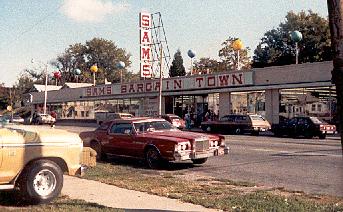 This Sam's Bargain Town on Truman Road in Kansas City was perhaps the oldest of four such stores located around the area as far back as the mid-'50s.
This Sam's Bargain Town on Truman Road in Kansas City was perhaps the oldest of four such stores located around the area as far back as the mid-'50s.
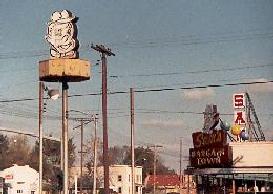 More Sam's signage from the same location on Truman Road. Note the shadow-obscured sign on the corner of the building in the background with the store's name on it.
More Sam's signage from the same location on Truman Road. Note the shadow-obscured sign on the corner of the building in the background with the store's name on it.
Interior shots of Sam's Bargain Town on Truman Road.
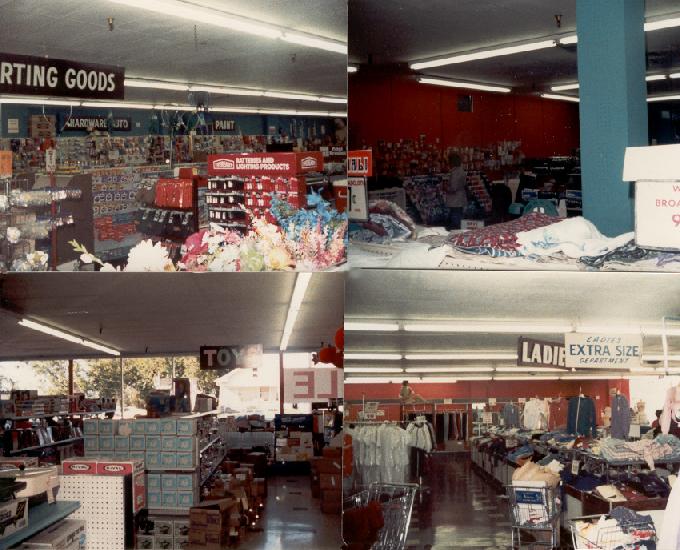
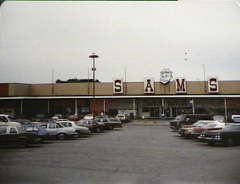 Here's another Sam's K.C. location, this one in Raytown. Scroll to the top of this page to see a nighttime shot of the sign.
Here's another Sam's K.C. location, this one in Raytown. Scroll to the top of this page to see a nighttime shot of the sign.
 Here's another sign that accompanied the Raytown unit, featuring a wonderfully-nostalgic trademark of yesteryear's discount stores: the store's name spelled out in individual blocks, each one on it's own separate pole and laid out in staggered fashion. A similar type of display was used by the old Spartan-Atlantic chain, which also had a couple of Kansas City stores.
Here's another sign that accompanied the Raytown unit, featuring a wonderfully-nostalgic trademark of yesteryear's discount stores: the store's name spelled out in individual blocks, each one on it's own separate pole and laid out in staggered fashion. A similar type of display was used by the old Spartan-Atlantic chain, which also had a couple of Kansas City stores.
Click on this thumbnail to check out a 1965 Christmas newspaper ad for Sam's: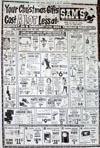
|
Zayre One of the first-generation Zayre stores was this one in a Bangor, Maine shopping plaza, seen close-up underneath. Next to it is a shot of a similar store missing its "E", courtesy of Shaun Qualdieri (thanks). Pictured at bottom is a later-built Zayre in Dubuque, Iowa.
Here is yet another vintage Zayre, complete with its Auto Center, courtesy of Brett (thanks)
Zayre was one of the first major discount chains, having opened their first location around 1956, same as Sam's above. Having lived in the midwest all my life, I was unfamiliar with Zayre, which was pretty big in the east and the New England states. They did have one Iowa location, in Dubuque, which I visited in 1982. When they folded, many locations were replaced by Ames Discount Stores, which began as a chain in 1958 and has now closed all remaining units after a troubled period of trying to stay alive as the fourth-largest discount chain behind K Mart.
Thanks to Alan Stephenson for these scans of another GEX Membership Card.
Treasure City in Lincoln, Nebraska. Omaha had one of these as well; each had previously been an International Super Store.
 |
Skagway: A rare independent survivor...until the Summer of 2015
Two shots of the great-looking sign--by day and by night--on the original Five Points Skagway store in Grand Island, Nebraska, built in 1959 and still operating when these pics were taken in the mid-1980s. |
|
The Five Points Skagway in Grand Island was one of the the last of the independently-owned discount stores, having survived at least 40 years of change, closings and takeovers. Established in 1959, it was originally a unique mix of grocery, appliances, electronics and regular discount store merchandise, and the first time I'd seen it around the mid-1980s, it appeared to be virtually unchanged, both inside and out. The sign on the outside of the building was particularly impressive: big letters on separate red ovals, lit up at night in red neon, as the above picture illustrates. How they kept it going that long was certainly a mystery to me. Sadly, as I discovered during a visit there in August of 2000, part of the challenge in keeping a 40 year-old non-corporate discount store such as this alive involved an occasional facelift, and in 1999 the business underwent a thorough remodeling, which included the dismantling of the older sign. The store's new sign--as well as the new paint job on the building exterior--was depressingly nondescript. Also, the separate building that once housed the TV and appliance section later dealt exclusively with video rentals. But Skagway genuinely deserves some level of respect for having that much staying power.
Later occupying the building was a furniture store now out of business itself; it was still a kick to go there and see the same arched ceiling with the same lights hanging from it, just as it looked when Skagway first opened.
A sad postscript to the Skagway saga: both locations are now history. The Five Points location closed in May 2015 and will eventually be demolished for a Super Saver supermarket. The other, more recent Skagway was also closed at the same time. An exec said they didn't allow the company to grow and had to give up on both locations. As of this writing there is no word on what will replace the Locust Street location--but as far as I'm concerned, it ought to be a Target store. They never had one in Grand Island before, and with Skagway and their Kmart both now gone, they might as well join the 21st Century. Farewell, Skagway; you will be missed. |
|
Various shots of Omaha's ex-Skagway. The upper left picture was taken when it was Osco and about to close; the other three were taken while it was still a Skaggs Family Center. |

|
|
|
|
|